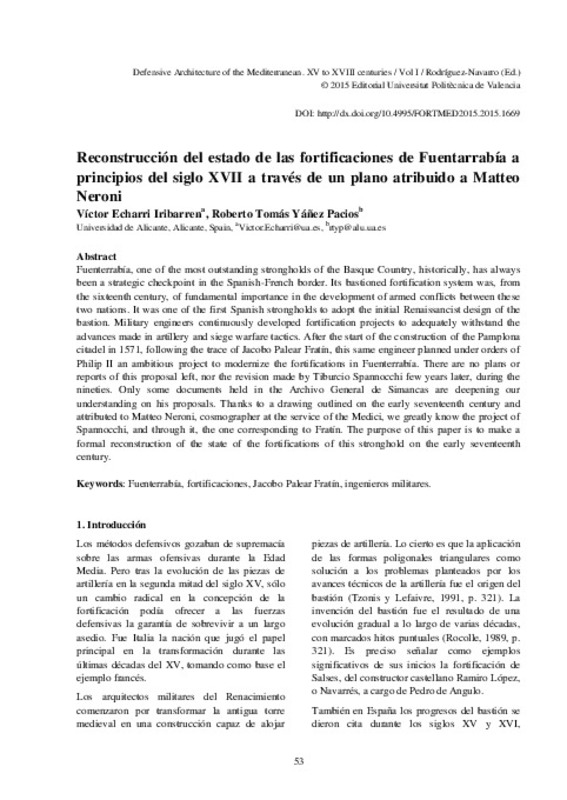JavaScript is disabled for your browser. Some features of this site may not work without it.
Buscar en RiuNet
Listar
Mi cuenta
Estadísticas
Ayuda RiuNet
Admin. UPV
Reconstrucción del estado de las fortificaciones de Fuentarrabía a principios del siglo XVII a través de un plano atribuido a Matteo Neroni
Mostrar el registro sencillo del ítem
Ficheros en el ítem
| dc.contributor.author | Echarri Iribarren, Víctor
|
es_ES |
| dc.contributor.author | Yáñez Pacios, Roberto
|
es_ES |
| dc.coverage.spatial | east=-1.8001487999999881; north=43.37084339999999; name=Hondarribia, Guipúscoa, Espanya | |
| dc.date.accessioned | 2018-01-17T07:54:38Z | |
| dc.date.available | 2018-01-17T07:54:38Z | |
| dc.date.issued | 2015-10-16 | |
| dc.identifier.isbn | 9788490483770 | |
| dc.identifier.uri | http://hdl.handle.net/10251/94927 | |
| dc.description.abstract | [EN] Fuenterrabía, one of the most outstanding strongholds of the Basque Country, historically, has always been a strategic checkpoint in the Spanish-French border. Its bastioned fortification system was, from the sixteenth century, of fundamental importance in the development of armed conflicts between these two nations. It was one of the first Spanish strongholds to adopt the initial Renaissancist design of the bastion. Military engineers continuously developed fortification projects to adequately withstand the advances made in artillery and siege warfare tactics. After the start of the construction of the Pamplona citadel in 1571, following the trace of Jacobo Palear Fratín, this same engineer planned under orders of Philip II an ambitious project to modernize the fortifications in Fuenterrabía. There are no plans or reports of this proposal left, nor the revision made by Tiburcio Spannocchi few years later, during the nineties. Only some documents held in the Archivo General de Simancas are deepening our understanding on his proposals. Thanks to a drawing outlined on the early seventeenth century and attributed to Matteo Neroni, cosmographer at the service of the Medici, we greatly know the project of Spannocchi, and through it, the one corresponding to Fratín. The purpose of this paper is to make a formal reconstruction of the state of the fortifications of this stronghold on the early seventeenth century. | es_ES |
| dc.format.extent | 8 | es_ES |
| dc.language | Español | es_ES |
| dc.publisher | Editorial Universitat Politècnica de València | es_ES |
| dc.relation.ispartof | Defensive architecture of the mediterranean: XV to XVIII centuries. Vol. I | es_ES |
| dc.rights | Reconocimiento - No comercial - Sin obra derivada (by-nc-nd) | es_ES |
| dc.subject | Fortifications | es_ES |
| dc.subject | Mediterranean | es_ES |
| dc.subject | Modern age | es_ES |
| dc.subject | Built Heritage | es_ES |
| dc.subject | Fuenterrabía | es_ES |
| dc.subject | Jacobo Palear Fratín | es_ES |
| dc.subject | Ingenieros militares | es_ES |
| dc.title | Reconstrucción del estado de las fortificaciones de Fuentarrabía a principios del siglo XVII a través de un plano atribuido a Matteo Neroni | es_ES |
| dc.type | Capítulo de libro | es_ES |
| dc.type | Comunicación en congreso | es_ES |
| dc.identifier.doi | 10.4995/FORTMED2015.2015.1669 | |
| dc.rights.accessRights | Abierto | es_ES |
| dc.description.bibliographicCitation | Echarri Iribarren, V.; Yáñez Pacios, R. (2015). Reconstrucción del estado de las fortificaciones de Fuentarrabía a principios del siglo XVII a través de un plano atribuido a Matteo Neroni. En Defensive architecture of the mediterranean: XV to XVIII centuries. Vol. I. Editorial Universitat Politècnica de València. 53-60. https://doi.org/10.4995/FORTMED2015.2015.1669 | es_ES |
| dc.description.accrualMethod | OCS | es_ES |
| dc.relation.conferencename | FORTMED2015 - International Conference on Modern Age Fortifications of the Western Mediterranean coast | es_ES |
| dc.relation.conferencedate | October 15-17,2015 | es_ES |
| dc.relation.conferenceplace | Valencia, Spain | es_ES |
| dc.relation.publisherversion | http://ocs.editorial.upv.es/index.php/FORTMED/FORTMED2015/paper/view/1669 | es_ES |
| dc.description.upvformatpinicio | 53 | es_ES |
| dc.description.upvformatpfin | 60 | es_ES |
| dc.type.version | info:eu-repo/semantics/publishedVersion | es_ES |
| dc.relation.pasarela | OCS\1669 | es_ES |








